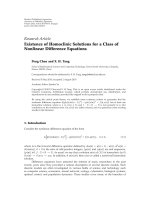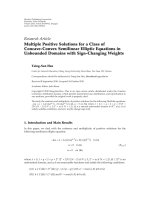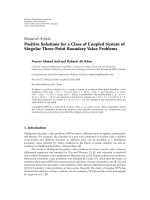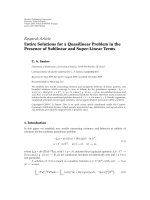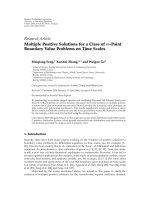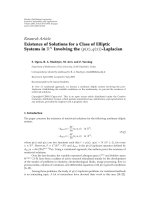Research on proposing solutions for sustainable use of coastal wetland resources in the context of climate change in dong rui area, tien yen district, quang ninh province
Bạn đang xem bản rút gọn của tài liệu. Xem và tải ngay bản đầy đủ của tài liệu tại đây (4.28 MB, 119 trang )
VIETNAM NATIONAL UNIVERSITY, HANOI
VIETNAM JAPAN UNIVERSITY
BUI THI LAN
RESEARCH ON PROPOSING SOLUTIONS
FOR SUSTAINABLE USE OF
COASTAL WETLAND RESOURCES
IN THE CONTEXT OF CLIMATE CHANGE
IN DONG RUI AREA, TIEN YEN DISTRICT,
QUANG NINH PROVINCE
MASTER’S THESIS
VIETNAM NATIONAL UNIVERSITY, HANOI
VIETNAM JAPAN UNIVERSITY
BUI THI LAN
RESEARCH ON PROPOSING SOLUTIONS
FOR SUSTAINABLE USE OF
COASTAL WETLAND RESOURCES
IN THE CONTEXT OF CLIMATE CHANGE
IN DONG RUI AREA, TIEN YEN DISTRICT,
QUANG NINH PROVINCE
MASTER PROGRAM IN CLIMATE CHANGE AND DEVELOPMENT
CODE: 8900201.02QTD
RESEARCH SUPERVISOR
Prof. Dr. MAI TRONG NHUAN
Dr. LUU VIET DUNG
Hanoi, 2021
PLEDGE
I assure that this thesis is the result of my own research and has not been published.
The use of other research’s results and other documents must comply with the
regulations. The citations and references to documents, books, research paper, and
websites must be in the list of references of the thesis.
Author of the thesis
Bui Thi Lan
TABLE OF CONTENT
PLEDGE
TABLE OF CONTENT
LIST OF TABLES
i
LIST OF FIGURES
ii
LIST OF ABBREVIATION
iv
ACKNOWLEDGEMENT
v
Chapter 1 INTRODUCTION
1
1.1. Background
1
1.1.1. Background ..................................................................................................... 1
1.1.2. Rationale for choosing Dong Rui wetlands .................................................... 2
1.2. Research objectives and tasks
3
1.3. Research question and hypothesis
7
1.3.1. Research question ........................................................................................... 7
1.3.2. Research hypothesis ........................................................................................ 7
1.4. Objects and Scope of the research
7
1.4.1. Research objects .............................................................................................. 7
1.4.2. Scope ............................................................................................................... 8
1.5. Novelty and Significance of the research
8
1.5.1. Novelty ............................................................................................................. 8
1.5.2. Scientific significance...................................................................................... 8
1.5.3. Practical significance...................................................................................... 8
1.6. Theoretical basis for the research
9
1.6.1. Wetland resources ........................................................................................... 9
1.6.2. The concept of sustainability and sustainability of wetland resources ......... 10
1.6.3. Sustainable use & principles for sustainable use of coastal wetlands ......... 11
1.7. Overview of related studies
12
1.7.1. Wetland resources in CC context .................................................................. 12
1.7.2. Sustainable use of coastal wetland resources ............................................... 15
1.7.3. Frameworks for assessment of impacts on wetlands .................................... 17
Chapter 2 MATERIALS AND METHODOLOGIES
25
2.1. Overview of the study site
25
2.1.1. Physical features ........................................................................................... 25
2.1.2. Socio-economic features ............................................................................... 26
2.2. Research analytical framework
26
2.3. Approaches
28
2.3.1. Systematic approach ..................................................................................... 28
2.3.2. Ecosystem approach...................................................................................... 28
2.3.3. Bottom-up approach...................................................................................... 28
2.3.4. Trans-disciplinary approach ......................................................................... 28
2.3.5. Sustainable development approach .............................................................. 29
2.4. Data collection
29
2.5. Methods
30
2.5.1. Desk research ................................................................................................ 32
2.5.2. Social survey ................................................................................................. 32
2.5.3. Field survey ................................................................................................... 36
2.5.4. Statistical analysis ......................................................................................... 38
2.5.5. Mapping ........................................................................................................ 38
2.5.6. Expert consultation ....................................................................................... 39
2.5.7. Indicator-based assessment .......................................................................... 39
Chapter 3 RESULTS AND DISCUSSION
51
3.1. Climate Change and Climate Change impact
51
3.1.1. Climate Change manifestation ...................................................................... 51
3.1.2. Climate Change impacts – the driving force ................................................ 57
3.2. Human driving force and pressure on wetland resources
60
3.2.1. The human driving forces.............................................................................. 60
3.2.2. The human pressure on wetlands .................................................................. 63
3.3. The state and impact of the wetland resources
67
3.3.1. The state of environmental quality ................................................................ 67
3.3.2. The state of ecosystem of Dong Rui wetlands ............................................... 70
3.3.3. The state of biodiversity of coastal species of Dong Rui wetlands ............... 72
3.3.4. The impact: change in productivity of wetland-related activities ................ 74
3.4. The societal response toward wetlands
76
3.4.1. Local people’s awareness and willingness toward wetlands ....................... 76
3.4.2. The efficiency of the wetland safeguard system ............................................ 78
3.5. Overall assessment of the sustainability of the wetland resources in Dong Rui
Commune, Tien yen District, Quang Ninh Province
82
3.6. Solutions for sustainable use of wetland resources
85
3.6.1. The bottom-up & systematic approach in sustainable use of wetland
resources ..................................................................................................................... 85
3.6.2. Solutions to deal with the driving forces ....................................................... 87
3.6.3. Solutions to deal with the pressure ............................................................... 88
3.6.4. Solutions to enhance societal response ......................................................... 89
Chapter 4 CONCLUSION AND RECOMMENDATION
90
3.1. Conclusions
90
3.2. Limitation & Recommendation
91
REFERENCES
92
APPENDIX 96
LIST OF TABLES
Table 1-1: Research objectives and tasks ........................................................................4
Table 1-2: Global contribution of mangroves and other coastal habitats to carbon
sequestration in the global coastal ocean.......................................................................12
Table 1-3: Derivation of criteria and indicators of sustainability for inland wetland
systems...........................................................................................................................19
Table 1-4: The Pressure-status-response model for wetland assessment ......................20
Table 1-5: Overview of the identified overall trend in the Mediterranean wetlands ....22
Table 2-1: Data used in the research .............................................................................29
Table 2-2: Research methods ........................................................................................30
Table 2-3: Social survey activities ................................................................................33
Table 2-4: Field survey activities ..................................................................................36
Table 2-5: The sustainability assessment indicators of wetland resources in Dong Rui
commune, Tien Yen district, Quang Ninh province .....................................................44
Table 3-1: Indicator PSR02 score..................................................................................54
Table 3-2: Indicator PSR02 score..................................................................................56
Table 3-3: Indicator PSR01 score..................................................................................59
Table 3-4: Indicator PSR04 score..................................................................................62
Table 3-5: Self-evaluation on resource-use pressure on the wetlands ..........................63
Table 3-6: Indicator PSR06 score..................................................................................64
Table 3-7: Indicator PSR05 score..................................................................................67
Table 3-8: Indicator PSR07 score..................................................................................68
Table 3-9: Indicator PSR08 score..................................................................................68
Table 3-10: Indicator PSR09 score................................................................................68
Table 3-11: Wetland classification ................................................................................71
Table 3-12: Indicator PSR11 score................................................................................73
Table 3-13: Indicator PSR12 score................................................................................75
Table 3-14: Indicator PSR13 score................................................................................77
Table 3-15: Evaluation of the local people on the efficiency of the wetland institution
in Dong Rui commune, Tien Yen district, Quang Ninh province .................................79
Table 3-16: Indicator PSR14 score................................................................................80
Table 3-17: The sustainability assessment score by component ...................................82
Table 3-18: Challenges for sustainable use of wetland resources in Dong Rui
commune, Tien Yen district, Quang Ninh province .....................................................86
Table 3-19: Some solutions to deal with the driving forces ..........................................87
Table 3-20: Some solutions to deal with the pressure ...................................................88
Table 3-21: Some solutions to enhance societal response ............................................89
i
LIST OF FIGURES
Figure 1-1: The ecosystem services of Dong Rui wetland ............................................14
Figure 1-2: Millennium Ecosystem Assessment Conceptual Framework ....................18
Figure 1-3: DPSIR approach for mangrove assessment ................................................23
Figure 1-4: DPSIR approach for assessment of sandy beach in the northeast coast .....24
Figure 2-1: Map of the study site ..................................................................................25
Figure 2-2: The research framework .............................................................................27
Figure 2-3: Map of the surveyed households ................................................................33
Figure 2-4: Map of the observation sites and route .......................................................36
Figure 2-5: Procedure of Sustainability index calculation ............................................43
Figure 3-1: Change in annual temperature during 1990-2020 & forecast until 2070 ...51
Figure 3-2: Change in maximum temperature during 1990-2020 & forecast until 2070
.......................................................................................................................................51
Figure 3-3: Change in minimum temperature during 1990-2020 & forecast until 2070
.......................................................................................................................................52
Figure 3-4: Total annual precipitation & maximum precipitation in 1990-2020 ..........53
Figure 3-5: Number of rainy days/year in 1990-2020 ...................................................53
Figure 3-6: Change of climate extreme conditions in Dong Rui commune, Tien Yen
district, Quang Ninh province .......................................................................................55
Figure 3-7: Number of typhoons in coastal region of Vietnam during the 1945-2019
period .............................................................................................................................56
Figure 3-8: Livelihoods in Dong Rui commune, Tien Yen district, Quang Ninh
province .........................................................................................................................57
Figure 3-9: CC impact on human activities in Dong Rui commune, Tien Yen district,
Quang Ninh province ....................................................................................................58
Figure 3-10: Degree of temperature change impact in Dong Rui commune, Tien Yen
district, Quang Ninh province .......................................................................................58
Figure 3-11: Degree of precipitation change impact in Dong Rui commune, Tien Yen
district, Quang Ninh province .......................................................................................59
Figure 3-12: Degree of impact of typhoon and other climate-induced hazards in Dong
Rui commune, Tien Yen district, Quang Ninh province ...............................................59
Figure 3-13: Main income sources of local households in Dong Rui commune, Tien
Yen district, Quang Ninh province ................................................................................61
Figure 3-14: The degree of dependency on wetland resources for livelihoods in Dong
Rui commune, Tien Yen district, Quang Ninh province ...............................................62
Figure 3-15: Wetland resource-use by percentage in Dong Rui commune, Tien Yen
district, Quang Ninh province .......................................................................................63
Figure 3-16: Map of Dong Rui's land use in 2019 ........................................................66
Figure 3-17: Dong Rui's environmental quality ............................................................69
Figure 3-18: Map of distribution of wetland ecosystems in Tien Yen district (Dang et
al., 2020) ........................................................................................................................70
Figure 3-19: Productivity change of wetland-related activities in Dong Rui commune,
Tien Yen district, Quang Ninh province .......................................................................74
ii
Figure 3-20: Action when facing productivity reduction in Dong Rui commune, Tien
Yen district, Quang Ninh province ................................................................................75
Figure 3-21: Local people's awareness about wetland values in Dong Rui commune,
Tien Yen district, Quang Ninh province .......................................................................76
Figure 3-22: Local people's willingness to participate in wetland conservation in Dong
Rui commune, Tien Yen district, Quang Ninh province ...............................................77
Figure 3-23: The sustainability indicator score .............................................................83
Figure 3-24: Sustainability of Dong Rui wetlands ........................................................84
Figure 3-25: The bottom-up & systematic approaches in identification of challenges in
sustainable use of wetland resources in Dong Rui commune, Tien Yen district, Quang
Ninh province ................................................................................................................85
iii
LIST OF ABBREVIATION
Abbreviation
AR4
AR5
CC
DPSIR
DRR
EEA
IPCC
MONRE
Ramsar
RCP
SD
SDGs
SLR
Interpretation
IPCC’s Fourth Assessment Report
IPCC’s Fifth Assessment Report
Climate Change
Driving force – Pressure – State – Impact – Response
Disaster Risk Reduction
European Environment Agency
International Panel on Climate Change
Ministry of Natural Resources and Environment
Ramsar Convention on Wetlands
Representative Concentration Pathway
Sustainable Development
Sustainable Development Goals
Sea-Level Rise
iv
ACKNOWLEDGEMENT
First and foremost, I would like to convey my utmost gratitude to Prof. Dr. Mai Trong
Nhuan and Dr. Luu Viet Dung, my supervisors, for their big support and instruction
for the master’s thesis. I will not be able to complete this without their guidance and
encouragement.
My appreciation and gratitude also go to the master program in Climate Change and
Development (MCCD) of Vietnam - Japan University and all of its amazing lecturers,
staff, and students for their assistance and companion during my journey with MCCD.
I owe my gratitude to the VNU Key Laboratory of Geoenvironment and Climate
Change Response (GEO-CRE) staff for their support during the completion of this
master’s thesis. I also thank the research team from VNU University of Science, led by
Prof. Dr. Nguyen Cao Huan for the permission to join the field trip to Dong Rui
commune, Tien Yen district, Quang Ninh province. In addition, I have received the
support from the VNU project no. TXTCN20.06 which is important to the
accomplishment of my master’s thesis, and I am so grateful for that.
Furthermore, I would like to express my gratitude to the staff and local people of Dong
Rui commune, Tien Yen district, Quang Ninh province for their hospitality and
willingness in sharing the information which is the integral part of this master’s thesis.
Last but not least, I am indebted to my beloved family and my dear friends for their
love, care, and encouragement. The master’s thesis would not have been possible
without their inputs.
v
Chapter 1 INTRODUCTION
1.1.
Background
1.1.1. Background
Climate Change (CC) has become one of the biggest challenges globally, especially in
the current context when all nations are making progress in achieving the Sustainable
Development Goals (SDGs). According to the Fourth Assessment Report (AR4) by the
International Panel on Climate Change (IPCC), different emission scenarios show that
CC and Global Warming has changed climatic variables like temperature,
precipitation, and sea-level rise (SLR), as well as has accelerated the frequency and
intensity of extreme weather events (IPCC, 2007). These changes severely affect both
nature and the human systems worldwide.
As estimated in the Global Climate Risk Index 2021, during the 2000-2019 period,
over 475,000 people died, 2.56 trillion USD lost due to the occurrence of 11,000
extreme weather events (Eckstein et al., 2021). Accordingly, Vietnam ranked 13th in
the overall Climate Risk Index for the period. 2020 has been a tough year for the
country with a series of severe weather events. Following the report by the Vietnam
Disaster Management Authority, Vietnam has gone through 13 storms in the East Sea,
264
thunderstorms/whirlwind/heavy
rain
in
49
cities/
provinces,
118
floods/flashflood/landslide, 86 earthquakes, and a series of severe droughts, saline
intrusion, erosion, or sea dyke subsidence in many parts of the country in the year of
2020. These disasters have caused loss to 353 lives and injuries of 876 people; in
estimation, 35,181 billion VND lost was one of the direct impacts.
Research on CC in Vietnam shows that over the past 50 years, the annual average
temperature of the country increases about 0.5ºC, precipitation increases in the South,
decreases in the North, and extreme climatic conditions like typhoon, flood, tropical
depression, drought, or prolonged heat tend to increase (Tân & Thành, 2013).
Accordingly, the ecosystem and socio-economic activities in the coastal zone are
vulnerable under impacts of environmental depletion, changes in temperature,
precipitation, SLR, and extreme weather events. Undoubtedly, CC is threatening the
sustainability of the coastal zone of Vietnam.
1
1.1.2. Rationale for choosing Dong Rui wetlands
Dong Rui is an island commune of Tien Yen district, Quang Ninh province; the
commune is surrounded by coastal wetlands, mostly mangrove forests, and is
beneficial from rich natural resources. In the context of CC, Dong Rui has been facing
unexpected and complicated climate conditions, causing difficulties for both the
natural ecosystem and human activities. Annual temperature in Tien Yen district
shows an increasing trend while annual precipitation has decreasing trend during the
1980-2010 period. Following the Representative Concentration Pathway 8.5 (RCP
8.5), by the end of the 21st century, the annual average temperature in Quang Ninh
will increase by 3.6ºC, the total annual precipitation will increase by 36.8% in
comparison with the baseline period (1986-2005). In estimation, 4.79% of the total
area (mostly in the coastal zone) will become inundated if the sea level rises by 100cm
(MONRE, 2016). Like other coastal areas, Dong Rui is also sensitive to CC potentials,
like typhoons, saline intrusion, coastal erosion, or SLR. Furthermore, lying in the river
mouth area and located close to the industrial zone of Ba Che district, the commune is
under the pressure of environmental pollution and other human activities.
Fortunately, Dong Rui’s wetland resources offer plenty of advantages and potentials
for social-economic development and climate response to the local community. Local
people are enjoying tremendous economic benefits from wetlands, significantly
through aquaculture-fishing activities and tourism. Mangrove forest is the predominant
wetland type of Dong Rui wetland, and the only primary mangrove forest left in
Vietnam. Dong Rui’s mangrove forest shows its roles in preventing and responding to
typhoons, waves, erosion, SLR...; in other words, the resource proves its value in
disaster risk reduction (DRR). Understanding the important values from the wetland
resources, Dong Rui has received attention and investment from the Vietnamese
government of all levels and from international organizations/governments, in which
mangrove forest conservation is a highlight. So far, many pieces of research have been
conducted in the region with a focus on the values of the mangrove forests, its diverse
ecosystems, and the state of use of the resources.
In short, the Dong Rui wetland resources are precious assets for the locality, they
contribute significantly to CC response and socio-economic development. Sadly, CC
2
and human intervention are degrading the resources. In such context, there arises the
need for solutions for sustainable use of wetland resources, so that we can continue to
enjoy the values taken from it, while keep maintaining the core values and
sustainability of the resources, still. To do so, it is necessary to propose a
comprehensive assessment framework to understand the level of sustainability of the
resources. From such understanding and assessment, appropriate solutions will be
proposed.
Apparently, ensuring the sustainability of wetland resources plays key roles in
strengthening adaptive capacity and resilience, striving for SD under CC setting not
only in Dong Rui area but also in the whole country. That is one of the reasons that
encourages the researcher to propose “Research on proposing solutions for sustainable
use of coastal wetland resources in the context of CC in Dong Rui area, Tien Yen
district, Quang Ninh province”. It is expected that the research results will add value to
the current progress in responding to CC, fulfilling SDGs.
1.2.
Research objectives and tasks
The overall objective of the research is to propose solutions for sustainable use of
coastal wetland resources in the context of CC in Dong Rui area, Tien Yen district,
Quang Ninh province.
Correspondingly, the three specific objectives are: (O1) Identify CC issues, and its
impacts on wetlands; (O2) Assess the sustainability of wetlands resources in CC
context; and (O3) Propose solution for SU of wetlands in CC context in the study site
(Table
1-1).
3
Table 1-1: Research objectives and tasks
Question &
Objective
Q1:
What
impacts
O1
Tasks/Activities
Hypothesis
are
on
Method
CC
Data resource
M2, Previous studies OP1: CC manifestations &
M3, M4 and
reports, future scenario
R1: CC & CC
wetlands?
social survey, site
wetlands
T2: Identifying CC impacts
M1,
M2,
observation
M3, M4
&
concept
wetland
OP4: Sustainability concept
M1, M6
What
is
sustainability of Dong
Rui Commune wetlands
T4: Constructing a basis for
sustainability
OP2: CC impacts on local
OP3: Coastal wetland resource
sustainability concept
Q2:
impacts
community
T3: Defining coastal wetland
resources
Key Result
M1,
the T1: Identify CC issues
H1: 2 ways of CC on
O2
Outputs
OP5: Set of sustainability
assessment,
assessment indicators
using DPSIR model
resource in CC context?
Previous studies
T5:
Identifying
human M1,
activities on the wetland
M2, and
M3, M4
R2:
reports, OP6: Human activities on from
social survey, site wetlands
activities
observation
wetlands
Pressure
human
on
4
Question &
Objective
Tasks/Activities
Hypothesis
Method
T6: Identifying environmental M1,
state in the study site
T7:
Identifying
response
toward
societal
wetlands
resources
M2,
Data resource
Outputs
OP7: Environmental quality
M3, M4
index
M1,
OP8: Societal response toward
M2,
M3, M4
wetlands
H2: Dong Rui wetland
resource is at medium
level
because
it
is
T8: Investigating current state
of the wetlands
and
M2,
M3,
M4,
M5
severely affected by CC
impacts
M1,
Key Result
R3:
OP9: Wetland characteristics Characteristics
and biodiversity
and
state
of
wetland resources
human
OP10: Results of driving force
activities
T9:
sustainability
assessment
following
constructed
basis
& pressure on wetlands
Implementing
the
M6, M7
R4:
Dong
Rui
OP11: Results of state & coastal wetland’s
impact on wetlands
OP12: Results of response on
sustainability
assessment result
wetlands
5
Question &
Objective
Tasks/Activities
Hypothesis
Q3: What are solutions
for sustainable use of
wetland resources in the
context of CC
Method
Data resource
Outputs
SU
concept
Key Result
T10: Defining SU of wetland
OP13:
&
resources & principles for SU M1, M7
principles for SU of wetland
of wetland resource
resources
H3: it requires require
the
integration
and
synergy of institution
O3
and policy, science and
technology,
development
and
participation
stakeholders,
wetlands in CC context
M1,
M2,
M3,
M4,
M6
OP14: Difficulties & obstacles R5: Solutions for
sustainable use of
for SU of wetland resource
the
finance,
capacity
enhancement
T11: Identify issues in SU of
for T12: Propose solutions for SU
M4, M6
and based on assessment results
wetland
resources
OP15: Solutions for SU
international
collaboration
6
1.3.
Research question and hypothesis
1.3.1. Research question
-
Q1: What are CC impacts on the wetlands in Dong Rui Commune, Tien Yen
District, Quang Ninh Province?
-
Q2: What is sustainability of Dong Rui Commune wetlands resource in CC
context?
-
Q3: What are solutions for sustainable use of wetland resources in the context
of CC in Dong Rui area, Tien Yen district, Quang Ninh province?
1.3.2. Research hypothesis
-
H1: CC impacts on the wetlands in Dong Rui Commune, Tien Yen District,
Quang Ninh Province are as follows: in a direct way, precipitation and
temperature change, SLR, and typhoons degrade the wetland area and
resources. In an indirect way, CC influences local people’s life and activities,
especially those who are reliant to wetland resources for living, eventually, it
affects land-use and resource-use behaviors.
-
H2: In the context of CC, the sustainability of Dong Rui wetland resources is at
medium level because it is severely affected by CC impacts and human
activities.
-
H3: Solutions for sustainable use of wetland resources in the context of CC
require the integration and synergy of institution and policy, science and
technology, finance, capacity development and participation enhancement for
stakeholders, and international collaboration.
1.4.
Objects and Scope of the research
1.4.1. Research objects
-
The wetland resources in Dong Rui area, Tien Yen district, Quang Ninh
province.
-
Sustainability of the coastal wetlands, pressures from CC, human activities on
wetlands, and societal responses in the context of climate change.
7
1.4.2. Scope
-
Study site: coastal wetlands of Dong Rui commune, Tien Yen district, Quang
Ninh province.
-
Duration: 2 years (from 2020-2021).
1.5.
Novelty and Significance of the research
1.5.1. Novelty
Though the concept of sustainability has become popular in recent decades, definition
for sustainability of wetland resources remains limited. Therefore, in this research, the
concept of wetland resource sustainability of the study site is applied for the first time.
Besides, this research recommends a set of indicators for assessment of the coastal
wetland resource sustainability in CC context. The assessment results set the
foundation for proposing solutions for sustainable use of the resources toward SD in
CC context.
1.5.2. Scientific significance
The concept of sustainability of wetland resources proposed in this research
contributes a new perspective in wetland research. Also, the research proposes a set of
assessment indicators for assessing sustainability of the wetland resource. It is
expected that the concept of sustainability and its assessment indicator would
contribute a scientific basis for future research concerning sustainability, and wetland
ecosystem, especially in CC context. The assessment results also become reference for
future research in Dong Rui area, Tien Yen district, Quang Ninh province.
1.5.3. Practical significance
The findings of the research support both policymakers and policy-enforcers in
integrating and building appropriate strategy and actions for CC response and
sustainable development. The framework proposed in the research also contributes a
reference for related parties in assessing sustainability of wetland resources not only
for the coastal wetland in Dong Rui area, Tien Yen district Quang Ninh province but
also for other coastal wetlands. Most importantly, it is expected that the proposed
8
solutions be noticed/executed to ensure a healthy and sustainable wetland ecosystem
while ensuring human’s benefits taken from the resources.
1.6.
Theoretical basis for the research
1.6.1. Wetland resources
Wetland is considered one of the richest and most diverse ecosystems on Earth. The
definition for wetlands by the Ramsar Convention on Wetlands (Ramsar) is widely
accepted as “areas of marsh, fen, peatland or water, whether natural or artificial,
permanent or temporary, with water that is static or flowing, fresh, brackish or salt,
including areas of marine water the depth of which at low tide does not exceed six
meters” (Ramsar, 1994). Based on such concept, in Vietnam, natural wetlands are
clearly defined as “marsh, peaty or permanently or temporarily wet areas, including
sea areas of a depth not exceeding 6 meters at the lowest tide level.” in the
Biodiversity Law (2008). Possessing unique ecosystem structure, wetlands have
wealthy biological resources, including a range “from micro-organisms to complex
and diversified forms of flora and fauna species” (Njoroge, 2012). Being a highly
productive ecosystem, coastal wetlands constitute an extremely important resource for
the coastal zone.
In Vietnam, following the Decision no. 1093/QĐ-TCMT dated August 22, 2016 on
Issuance of Technical Guidelines for Wetland Classification by the Vietnam
Environment Administration under MONRE, wetlands are clearly defined as “marsh,
peaty or permanently or temporarily wet areas, including sea areas of a depth not
exceeding 6 meters at the lowest tide level”. Coastal, marine wetlands (also known as
brackish-salt wetlands) are areas of saline, brackish water in coastal areas, small
islands and large island areas, affected by coastal tides. Wetlands offer tremendous
functions, namely: groundwater control, water filter and provision, climate control,
wave attenuation, coastal line protection, biodiversity conservation, platforms for
various economic activities like aquaculture, forestry, transportation, energy
production, tourism, mining… and so on (Nhuan et al, 2007).
Within the scope of this research, the author follows the definition for coastal wetlands
stipulated by the MONRE as stated above. And the coastal wetland resource is referred
to as the coastal wetland areas, and natural resources (soil, water, forest…), all
9
organisms or non-living things, no matter biotic or abiotic, tangible or intangible…
that can be exploited from the areas.
1.6.2. The concept of sustainability and sustainability of wetland resources
Sustainability is a complex concept that was widely known long ago, yet remains
ambiguity, whereas the term “sustainable development” has become more popular.
Though having some semantic similarities, sustainable development and sustainability
are 2 different concepts, and they must not be used interchangeably in many cases.
Sustainable development is publicly understood as “development that meets the needs
of the present without compromising the ability of future generations to meet their
own needs” since it was first introduced in the Report of the World Commission on
Environment and Development: Our common future (Brundtland & Khalid, 1987, p.
43). In the report, sustainability and sustainable development attempt to emphasize the
link between global economic development and the environment, and that
development must be intertwined with maintaining core ecosystems. Accordingly,
sustainability is used to assess the ability to maintain and develop a certain system or
integrated systems.
As defined by the US Environmental Protection Agency (USEPA), sustainability is
essential for human’s survival and well-being. And that achieving sustainability means
to create conditions for humans and nature to exist harmoniously (USEPA, 1969).
Sustainability is achieved only when there is full reconciliation between (1) economic
development; (2) meeting, on an equitable basis, growing and changing human needs
and aspirations; and (3) conserving limited natural resources and the capacity of the
environment to absorb the multiple stresses that are a consequence of human activities
(Hay & Mimura, 2006).
Though many studies have been conducted on sustainability recently, these studies
mostly focus on environmental sustainability. Specific ecosystem sustainability,
especially on wetlands remains limited.
―Over the normal cycle of disturbance events, maintains its characteristic
diversity of major functional groups, productivity, soil fertility, and rates of
biogeochemical cycling. In another respect, sustainability is perceived
10
mainly as the ability to sustain the functions, processes, and productivity of
ecological systems and ecology in the future‖
(Stuart Chapin III et al., 1996)
―…the capacity of a system to maintain output at a level of approximately
equal to or greater than its historical average, with the approximation
determined by the historical level of variability.‖
(Lynam & Herdt, 1989)
―Ecological sustainability means that, based on a long-term perspective, we
conserve the productivity of the waters, the soil and the ecosystem, and
reduce our impact on the natural environment and people’s health to a level
that the natural environment and humanity can handle‖
(University of Gävle, 2018)
In short, sustainability of the wetland resources conveys the ability to maintain its
values, functions, services, and biodiversity.
1.6.3. Sustainable use & principles for sustainable use of coastal wetlands
Toward use of wetland resources, wise use and sustainable use are the two widely
accepted orientations. According to the 3rd meeting of the contracting parties to the
Ramsar convention on wetlands, wise use and sustainable use (sustainable utilization)
are understood as:
“The wise use of wetlands is their sustainable utilization for the benefit
of humankind in a way compatible with the maintenance of the natural
properties of the ecosystem‖
―Sustainable utilization: human use of a wetland so that it may yield
the greatest continuous benefit to present generations while maintaining
its potential to meet the needs and aspirations of future generations‖
Both wise use and sustainable use implies the necessity to maintain core and vital
ecology functions of wetlands while meeting human’s interest from generation to
generation; ensure interest of related parties; ensure environment protection,
biodiversity conservation, and climate response. However, sustainable use focuses on
the conciliation of economy, society & environment, culture components, and
achievement of related SDGs.
11
The principles for sustainable use and conservation of wetland shall be made upon the
Decree no. 66/2019/ND-CP dated 29 July 2019, by the Prime Ministers of Vietnam on
preservation and sustainable use of wetlands. Accordingly, the researcher uses the
same definition for sustainable use (sustainable utilization) as explained by the
Ramsar. And proposals for sustainable use of wetland resources are made upon the
principles as the aforementioned principles by the Vietnamese government, through an
assessment of wetland sustainability in the context of climate change.
1.7.
Overview of related studies
1.7.1. Wetland resources in CC context
1.7.1.1.
Coastal wetlands values in climate response
Coastal wetland is a precious natural resource, playing crucial role in responding to
CC thanks to its tremendous ecosystem functions and services.
● For CC mitigation
Wetland is extremely important to CC mitigation. Mangrove forests, salt marshes, and
estuaries in the coastal wetlands show huge carbon sequestration capacity (Alongi,
2014) (Table 1-2).
Table 1-2: Global contribution of mangroves and other coastal habitats to carbon
sequestration in the global coastal ocean (Alongi, 2014)
Habitat
Area
(1012m2)
Mangroves
0.14 (0.5%)
Sequestration
rate
(gC m-2year-1)
174
Salt marshes
0.22 (0.8%)
150
33 (20%)
Seagrasses
Estuaries
Shelves
0.3 (1.1%)
1.1 (40%)
26 (93.6%)
54
45
17
16 (10%)
50 (30%)
44 (26%)
Total
Global carbon
sequestration
(Tg year-1)
24 (14%)
167
Assumes that depositional areas cover 10% of total shelf area
As a typical coastal wetland type, though mangrove’s total area just makes up less than
1% of the total area of tropical forest, its carbon sequestration is approximately 3% of
carbon sequestered by the world’s tropical forests (Table 1-2). Thanks to its amazing
carbon storage, carbon sequestration capacity, wetland conservation, especially
mangrove restoration contributes hugely to the current CC mitigation process.
● For CC adaptation
12
In general, wetland ecosystems provide rich natural resources for improving
livelihoods, and play an important role in regulating the climate, and protecting the
coast from natural disasters. On the one hand, wetlands bring in numerous
provisioning, supporting services, which is crucial to socio-economic development.
Mangrove reserves and supplies flora and fauna resources, including: forestry
products, habitats for plants and animals, bird migratory stops, nursery/breeding
grounds for aquacultures and other species, and so on (Ngọt et al., 2012). Clearly,
values obtained from the resource greatly support livelihood, eventually increasing the
resilience and adaptive capacity for local people in the coastal zone where is at a high
risk of climate change impacts. On the other hand, protecting the mangrove ecosystem
is of great importance for the coastal zone where it is highly vulnerable to climate
hazards, including floods, erosion, typhoons and sea level rise (Boateng, 2018).
Mangrove acts as a green dike to protect coastline from typhoons, tsunamis, or waves.
Development of mangrove accelerates soil/sediment accretion, preventing coastal
erosion effect.
● The contribution of Dong Rui wetlands to CC response
Dong Rui wetlands play important role in CC mitigation and adaptation thanks to its
unique and tremendous ecosystem functions and services.
Mangrove forest in Dong Rui commune shows huge capacity of Carbon sequestration
and offsetting atmospheric CO2 concentration with total ecosystem C storage of 1.81
(±0.34)×106 Mg C (Tue et al., 2020). With this great storage value, conservation and
restoration of Dong Rui mangrove forests is crucial for CC mitigation.
13
Cultural service:
aesthetic qualities
sense of well-being
Supporting service:
soil retention
nutrient cycling
oxygen production
habitat provision
Regulating service:
storm protection
saline intrusion
protection
Provisioning service:
resources from
mangrove forest (ex:
aquatic products)
Figure 1-1: The ecosystem services of Dong Rui wetland (adopted from Orchad et. al.,
2014)
Moreover, wetland resources bring in immense ecosystem services for CC adaptation
to the local community of Dong Rui commune, accordingly, the value in DRR and
livelihood improvement are well aware (Orchard et al., 2014). Possessing wetland’s
rich provisioning service, Dong Rui people are enjoying huge benefits from
aquaculture exploitation (462 tons in 2017), and aquaculture farming (181 tons in
2017) (Quang Ninh's DONRE, 2018).
In the context of ongoing climate change, the ecosystem services provided by the
wetlands and its resources contribute significantly to CC response.
1.7.1.2.
CC impacts on coastal wetlands
As the resources is highly dependent on hydrological regime, it will rely largely on
changes in climatic conditions. Apparently, CC constitutes a major driver that highly
influence the wetland resources (Ramsar; Lloréns & Lucas, 2008; Erwin, 2009).
Marsh wetland is among wetland types most impacted by water resources regulation
(Xu et al., 2019), moreover, the structure and functioning of wetland ecosystem is
influenced by sea level rise and storm surges (Lloréns & Lucas, 2008). Sea-level rise,
14
storms, sedimentation, and changing freshwater input are considered direct CC effects
on coastal wetland ecogeomorphology (Day et al., 2008).
In Vietnam, CC (temperature change, precipitation change, increased storm frequency,
SLR) and human activities (aquaculture & LU change, overexploitation and water
pollution) accelerate negative impacts on mangrove – the dominant wetland type
(Nhuan et al., 2015). The adaptive capacity and vulnerability level to CC of the
wetland resources is medium (p.164) whereas livelihoods of related stakeholders
decrease. Consequently, changes of wetlands result in biodiversity loss like decrease
of waterbirds, fishes, shrimps (Nhuan et al., 2015), and threat the existence and
development of mangrove ecosystem.
In short, due to the complex relationships and feedbacks among CC, human, and the
wetlands, wetland loss and degradation is expected to be intensified in CC context.
1.7.2. Sustainable use of coastal wetland resources
From such understanding of the importance of wetland resources in responding to CC,
and negative impacts of CC on the wetlands, it is apparent that sustainable use the
wetland resources is extremely crucial.
As it was clearly defined in section [1.6.3], sustainable use of the wetland resources is
promoted in a way to maintain the core and vital ecology functions of wetlands while
meeting human’s interest from generation to generation. Wetland conservation and
sustainable use of wetlands are advocated by various international organizations like
United nations (UN), Ramsar, Convention on Biological Diversity (CBD) as an effort
in achieving SDGs (UN, 2014; Rosa, 2017; Ramsar, 2018).
● International research
Though having received international attention and investment, the work on
management of wetlands faces certain difficulties, main obstacles in wetland
management include: information and awareness, policy, planning, and institutions
(Maltby et al., 1992). In term of biological resources in coastal wetlands,
environmental pollution, rising sea-level, and alien species invasion are considered
main factors limiting the resource from sustainable use (Tang et al., 2012). Land-use,
wetland use for cultivation of crops, grazing of livestock constitutes main threats to
15
